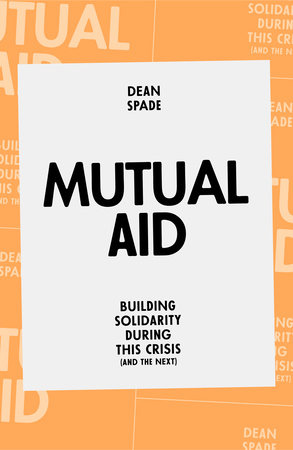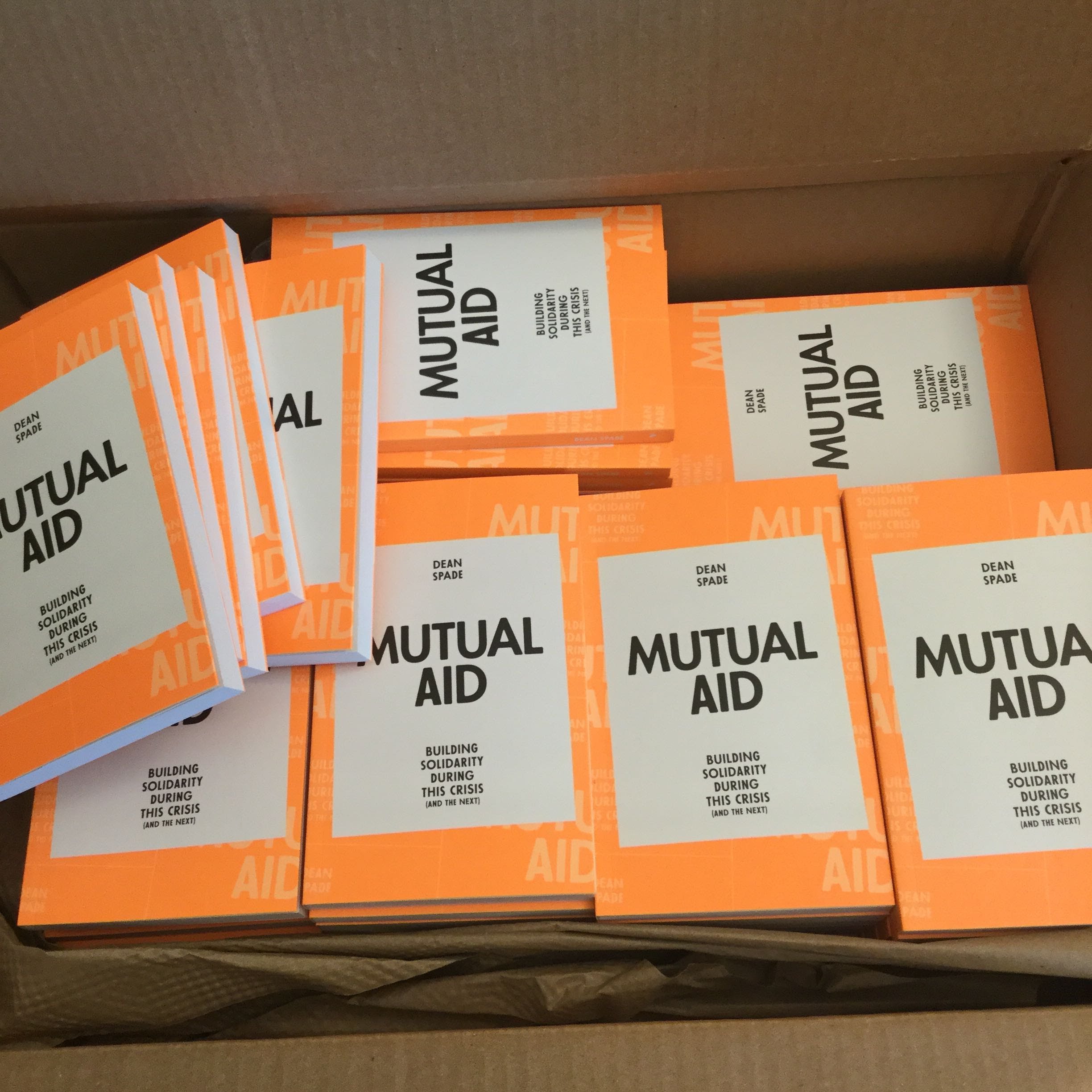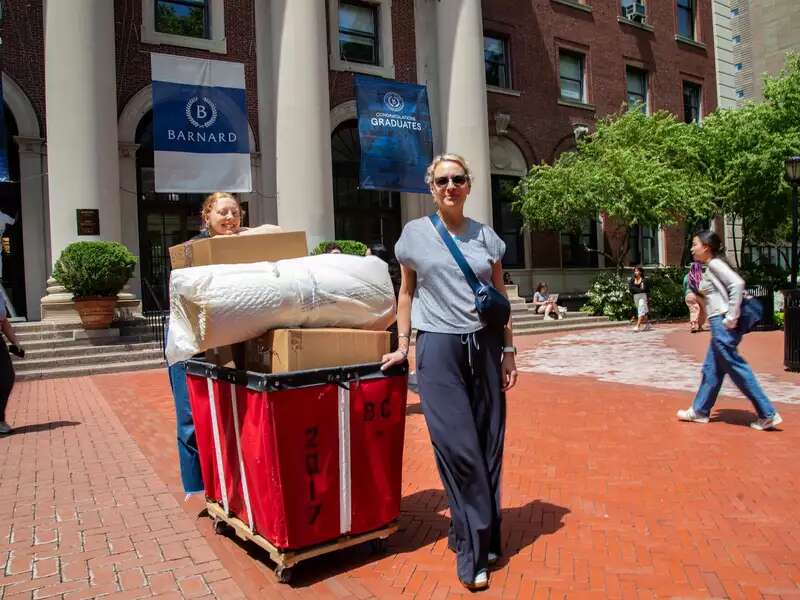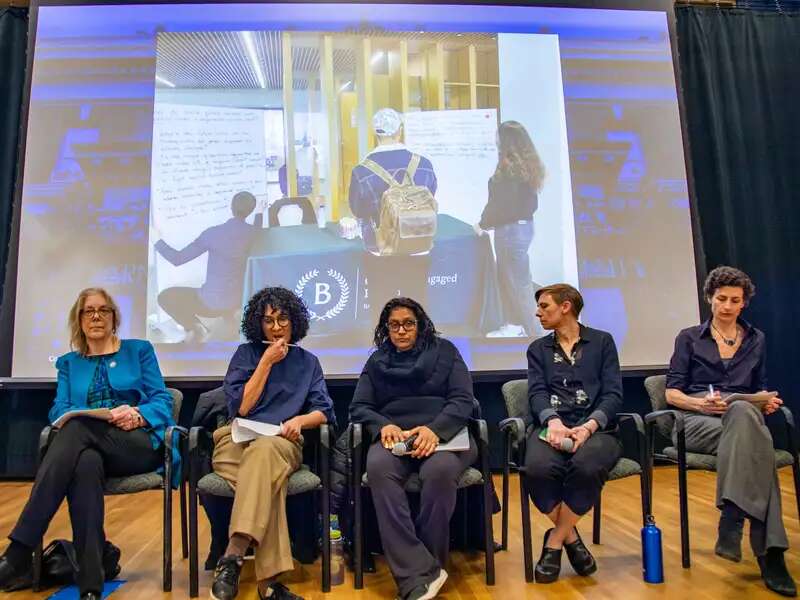[Main photo: Dean at a No New Youth Jail (NNYJ) action rally on April 20, 2018. Black and white photo credit: Molly Landreth]
On November 12, Dean Spade ’97, activist and associate professor at Seattle University School of Law, will join Mariame Kaba and Ejeris Dixon at a virtual Barnard Center for Research on Women (BCRW) event to celebrate the release of his new book, Mutual Aid: Building Solidarity During This Crisis (and the Next). A timely tool for activists who engage in justice work, Mutual Aid explains how the reciprocal act of giving and receiving is critical for effective organizing when working towards political change. The book offers practical tips for how to improve collaboration across groups, how to nurture a collective decision-making process, how to prevent and address conflict, and how to navigate burnout. (Register for the book event here.)
“There is nothing new about mutual aid — people have worked together to survive for all of human history,” Spade said. “But capitalism and colonialism created structures that have disrupted how people have historically connected with each other and shared everything they needed to survive. As people were forced into systems of wage labor and private property, and wealth became increasingly concentrated, our ways of caring for each other have become more and more tenuous.”
To help educators better engage new activists, Spade’s book includes a teaching guide that offers reflection questions for each chapter of the book. At BCRW’s November 12 event, “We Keep Each Other Safe: Mutual Aid for Survival and Solidarity,” Spade, a former BCRW Activist-in-Residence, will be in conversation with Kaba and Dixon about the role of mutual aid in movements to abolish prisons and policing and to end gender-based violence.
To learn more about mutual aid, the abolitionist movement, and how new activists can sustain movement work, read our “5 Questions With … Dean Spade” below.
How do you see mutual aid and its role in justice work over time, including today?
“Mutual aid” is one term among many used to describe collective coordination to meet survival needs, usually stemming from an awareness that the systems we have in place are not going to meet them. Those systems, in fact, have often created the crisis or are making things worse. We see examples of mutual aid in every single social movement, whether it’s people raising money for workers on strike, setting up a carpooling system during the Montgomery bus boycott, putting drinking water in the desert for migrants crossing the border, training each other in emergency medicine because ambulance response time in poor neighborhoods is too slow, raising money to pay for abortions for those who can’t afford them, or coordinating letter-writing to prisoners. These are mutual aid projects. They directly meet people’s survival needs and are based on a shared understanding that the conditions in which we are made to live are unjust.
Recently, mutual aid as a concept has been in the news more than ever [before] in my lifetime. When COVID-19 emerged, people started coordinating to deliver groceries and prescriptions to vulnerable people, making and distributing masks and hand sanitizer, and raising money for people who were losing jobs and ineligible for unemployment benefits. By the time the uprising against anti-Black racism and police violence brought people into the streets in early summer, the concept of mutual aid had gained significant traction in the media, and it was visible on the streets as people operated street medic teams at protests, offered each other free food and water, and defended each other from cops and white supremacists. COVID-19 mutual aid projects are ongoing, and as we face a worsening economic crisis, more people displaced by climate disasters, and ongoing police and right-wing violence, mutual aid will continue to be a key part of street protests and occupations of public space.
What are some practical tools that activists can use for sustaining movement work?
My new book is a lot about this very question: How can we avoid some of the common obstacles facing grassroots activists, like burnout, conflict, and difficulty with decision-making in groups? Our work is responsive to such intense conditions that sometimes we pay a lot of attention to what we are responding to “out there” and not as much to how we are working together inside our groups. This makes sense, but it can lead to problems. When we’re working together and we’ve all been raised in societies where we have rarely or never seen people model collective, horizontal decision-making — since we have usually been in spaces where there is a boss or some other authority figure telling us what to do — it takes some intention and care to try to learn how to build participatory groups that welcome new people and where everyone is listened to. Many groups default to informal hierarchies with racism, ableism, ageism, and patriarchy determining leadership. [Oftentimes], a founder or charismatic leader is the default decider, and when that person burns out or sells out, or misuses power and clashes with others in the group, groups fall apart.
It is essential that we actually study and practice new ways of making decisions together if we want to build groups that people stay in for the long haul and that don’t reproduce the worst patterns of our current society. We also have to learn how to have generative conflict. If we are working on things we really care about with other people, at some point there will be conflict. This does not mean that anyone is “bad.” We have to shake off our habits of trying to make someone else or ourselves “bad” and build new skills for giving and receiving feedback, being interested in other people’s wisdom and perspectives, holding the complexity of situations, and not throwing each other away.
Luckily, there are tons of awesome tools and materials to help us learn about these things coming out of the Transformative Justice movement. I highly recommend BCRW’s “Building Accountable Communities” video series, as well as all the work of Mariame Kaba and Andrea Ritchie at Interrupting Criminalization, a BCRW Social Justice Initiative.
Mutual Aid: Building Solidarity During This Crisis (and the Next) provides many models and tools for some of the basic infrastructure that grassroots organizations can set up to try to build a strong organizational culture that balances responsiveness and intentional planning, openness to new members and ensuring decision-making is well informed, and other complex dynamics facing groups. It includes tools for preventing and addressing burnout, identifying what kinds of leadership skills the group values and wants to cultivate in all the members, and engaging with conflict without throwing anyone away. It can be easy, especially in a capitalist, racist, sexist culture, for groups to only be concerned about output and how they look from the outside. It is essential, if we are to build sustainable groups and strong, powerful movements, that we learn to care about how we are doing the work and to practice our principles in all parts of the work, rather than sacrificing ourselves or each other for a short-term gain. To learn how to do this, we need to study what other groups have tried and are doing and to practice together. I hope this new book helps people find some useful tools for sustaining the work and addressing common obstacles that are coming up.
My work to popularize and theorize mutual aid work aims to [...] lift up the centrality of mutual aid for both surviving disaster and building powerful movements for change.
What would you tell the many people who protested against injustice for the first time this year?
I would encourage new activists to be careful of perfectionism. Perfectionism comes up in a lot of ways. Some people don’t take action because they are not certain how to choose which action to take or which will be “right,” and it immobilizes them. None of us actually ever know which of our interventions will have what results. We look at what others are doing and have done, we feel where we have a spark of interest or passion or drive, and we try things. Most people I know who have been in movements for decades have tried and continue to try lots of different tactics — they put on events, they write things, they do direct actions, they are deeply engaged with a mutual aid project or several, they make art. Nothing is ever satisfying in the sense that we are done or certain that it worked. Instead, we just keep putting our little leaves in the stream, not sure where they will end up, who will see them along the way, how long they will float. It’s a lifetime of experimentation, which hopefully takes the pressure off to be perfect.
Perfectionism also shows up inside groups and in individuals when we are unwilling to receive feedback or reevaluate what we are doing. We live in a culture of punishment and exile, so most of us are terrified of making mistakes. In a prison-based culture, when something difficult happens and someone is hurt, we go to two extremes: Either we minimize the harm that happened and ignore the hurt person, or we label the harm-doer as “bad” and punish and exclude them. As a result, most of us are terrified of admitting mistakes. This comes up frequently in groups where someone names racist, sexist, or ableist dynamics in the group or actions by a group member, and people jump into defensive and offensive positions. Sometimes the person whose behavior was named will disappear from the group and the movement. Sometimes they will try to smear the person who named their behavior, launching a campaign of defense. All of these reactions are conditioned by our society, and the more we can see them for what they are and try to practice being open to giving and receiving feedback without aiming to throw anyone away or defend our perfection, the more we can learn and grow in social movement work and stick around for the long haul. We need everyone mobilized — getting involved with social movement work and staying involved — more than ever as we face terrifying crises.
Why was it important for Mutual Aid to include a teaching guide?
I wrote the teaching guide for Mutual Aid with both classroom use and community reading group use in mind because I am eager for the book to be a tool for lots of people learning about social movements. In the U.S., popular mythology about how social change works makes mutual aid virtually invisible. The focus of the U.S. narrative about social change is about charismatic leaders and changes to the law, which leaves most people without ways to participate beyond voting or donating to nonprofits. In my experience, college and graduate school courses that explore social change or specific areas of resistance similarly tend to ignore mutual aid, despite its centrality to movements.
My work to popularize and theorize mutual aid work aims to refute this mythology and lift up the centrality of mutual aid for both surviving disaster and building powerful movements for change. Mutual aid is the on-ramp to social movement participation. Most people join movements because they need something that movement mutual aid projects are providing or they want to help others with survival needs. All large-scale social movements have mutual aid as a central strategy and practice. I hope this book will help more people who are trying to figure out how to be part of transformative change find mutual aid projects and groups and dig in.
How does the abolitionist movement use mutual aid, as you plan to discuss in your BCRW event?
My book includes a lot of examples from the abolitionist movement, and my book launch event with BCRW is a conversation with two brilliant abolitionist leaders, Mariame Kaba and Ejeris Dixon. Abolition is central to my understanding of mutual aid because abolition work is one of the key places I learned about the centrality of mutual aid to transformative social movements. Abolitionists seek to get rid of police, prisons, and borders and to build real safety in our communities based on people having what they need and in transforming cultures of sexism, racism, and violence. Abolitionists reject efforts to “fix” prisons, police, or border enforcement, knowing that most reforms end up expanding the budgets and reach of these harmful structures. The wisdom of abolitionist theory and praxis comes from mutual aid. Abolitionist theory and strategy comes from people who are currently inside prisons, experiencing police violence, or vulnerable to or experiencing immigration enforcement, and all people engaged with abolitionist work are committed to being guided by the wisdom of people confronting the system directly. It is by understanding the conditions on the ground that we come to realize the inadequacy of reforms.
For example, when the National Prison Rape Elimination Act (PREA) passed, that sounded like a great idea to many people on the outside. However, groups like Black and Pink that do direct mutual aid with queer and trans prisoners heard again and again from people inside that PREA is used to punish and separate queer and trans prisoners for expressing gender nonconformity and for consensual affection. Long-term, committed, high-volume mutual aid work to people in prisons is what allowed Black and Pink to build the relationships with people being targeted so that it was the first organization to raise the alarm about what the impact of PREA really was. This is a pattern across abolitionist work.
We assess reforms not based on what the systems of punishment say about themselves but based on what people being impacted by them say is happening on the ground. Mutual aid projects have always been central to abolitionist work because abolitionists are committed to stopping the harm of law enforcement and punishment systems, rather than simply creating good PR for those systems, which many reforms do, which means that abolitionists directly support people being targeted by those systems now and work to dismantle those systems brick by brick.
To learn more about mutual aid, watch Dean’s mutual aid explainer video below:




